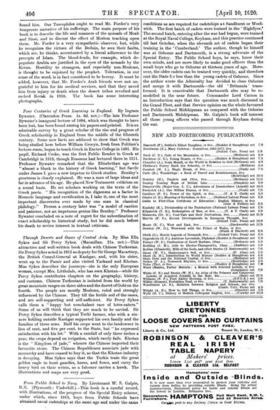Through Deserts and Oases of Central Asia. By Miss Ella
Sykes and sa Percy Sykes. (Macmillan. 21s. net.)—This attractive and well-written book deals with Chinese Turkestan. Sir Percy Sykes acted in 1915 as deputy for Sir George Macartney, the British Consul-General at Kashgar, and, with his sister, went up to the Pamir and also visited Yarkand and Khotan. Miss Sykes describes the journeys—she is the only European woman, except Mrs. Littledale, who has seen Khotan—while Sir Percy Sykes contributes chapters on the geography, history, and customs. Chinese Turkestan is isolated from the world by great mountain ranges on three sides and the desert of Gobi on the fourth. The people are mostly Moslems, ruled and strongly influenced by the Chinese. They till the fertile soil of the oases, and are self-supporting and self-sufficient. Sir Percy Sykes calls them a " happy but nonchalant race of lotos-eaters." Some of us will think that they are much to be envied.. Sir Percy Sykes describes a typical Turki farmer, who with a six- acre holding outside Kashgar supported his own family and the families of three sons. Half his crops went to the landowner in lieu of rent, and five per cent. to the State, but " he expressed satisfaction with his lot." With a rainfall of only three inches a year, the crops depend on irrigation, which rarely fails. Khotan is the " Kingdom of jade," whence the Chinese imported their favourite stone. The Chinese Republicans associate jade with monarchy and have ceased to buy it, so that the Khotan industry is decaying. Miss Sykes says that the Turkis train the great golden eagle to hunt gazelles, hares, and foxes, and carry the heavy bird on their wrists, as a falconer carries a hawk. The illustrations and maps are very good.


































 Previous page
Previous page